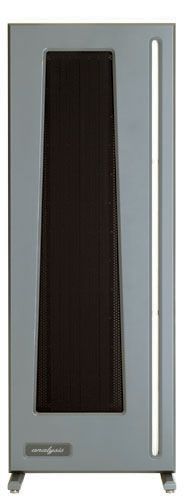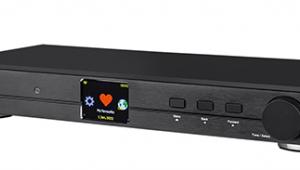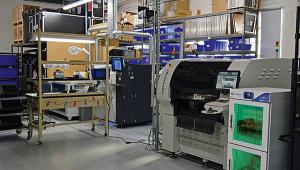Analysis Audio Omega (£14,500)
 Apogees, surely, risen from audio’s graveyard of well-intentioned but utterly impractical ideas? That’ll be the first thought of every red-bloodied audiophile who glances at these pages. But despite the astonishing resemblance in shape, distribution of drivers and slate grey colour of these door-sized dipoles to Apogee’s long-mourned full-range ribbons, they’d be mistaken.
Apogees, surely, risen from audio’s graveyard of well-intentioned but utterly impractical ideas? That’ll be the first thought of every red-bloodied audiophile who glances at these pages. But despite the astonishing resemblance in shape, distribution of drivers and slate grey colour of these door-sized dipoles to Apogee’s long-mourned full-range ribbons, they’d be mistaken.
Indeed, under the skin Analysis Audio’s Omega loudspeakers have little in common with their erstwhile lookalikes. Sure enough, they employ a long ribbon mid/treble driver down the inside edge of the large flat MDF baffle but the trapezoidal bass panel is a planar-magnetic design, far closer in execution to that of Magneplanar’s current crop [HFN, Mar ’11].
Unlike the classic Apogee Scintilla from 1985 [HFN, Jan ’11] with its aluminium foil bass panel and hand-cut 83-slit conductor pattern, the Omega’s main panel is fashioned from a lightweight polymer sheet that carries foil strips, top-to-bottom. These act as a distributed ‘voice-coil’ moving the entire panel within a field created by long magnetic bars attached to a perforated metal sheet at the rear of the cabinet frame. The simple first-order crossover is also buried within the lower section of this baffle, the scaffold a mere 6cm thick but a full 1.68m tall including feet.
NO TRAGEDY
Moreover, neither do these exotics hail from the US but (and as further evidence that high-end audio is mysteriously immune from the ravages of the world economy) from Greece. Analysis Audio along with amp specialists Ypsilon and Tsakiridis is operating in a financial climate that makes the UK’s credit crunch look like a period of unrivalled prosperity. And yet they continue to develop and grow thanks to the passion and deep pockets of music lovers across the globe.
Equally, parts for the Omega and its other ‘magnetic planar ribbon’ speakers are sourced from all over the world, including filter capacitors from Germany, rare-earth magnets from South America, polymer bass/mid panels from the UK, pleated ribbon leaf from France and glues from the US. From this diverse inventory, each and every Analysis Audio speaker is hand-crafted at its facility in Athens where production has continued since 1993.
CLOSET TO CONCERT
The Omega is capacious enough to fill a decent-sized UK living room, but it’s actually the middle model in a five-strong range, sitting above the 1.32m Epsilon and 1.12m Omicron. The 2.25m tall Amphitryon adopts a larger format still but the range-topping Orion comprises some four speakers, which appear to be a pair of Amphitryons with auxiliary base panels in another frame of equal size. This awesome combination was apparently designed for the US market to suit listeners with very large music rooms. For ‘very large room’ read ‘concert hall’.
For the Omega’s part, its recommended room placement is rather straightforward. Its UK distributor, Alternative Audio, suggested we place them in front of a largely empty wall with the rear wall occupied by a bookcase or absorptive heavy curtain (this apparently encourages a wider soundstage). The other approach is to have any absorption at the wall behind to get a more ‘pin-pointed focus’. I have curtains at both ends of the room, each adjustable in line with the degree of liveliness required. In the end I kept the curtains shut behind the dipoles and those behind me open.
Neither did I feel compelled to fit the metal spikes to its substantial feet – with or without these pins the top of the panel could be made to sway, springboard-like, without any movement at ground level.
VERY EASY LISTENING
Their insensitivity a given [see Lab Report, p59], powering up the Omegas was still within the compass of my resident 200W Devialet amplifier, itself fed from a custom media server solution hosting ripped CD, DVD-A and downloaded HD audio media on a solid-state drive. Even before I had spent a little time following Analysis Audio’s recommended siting for its Omegas, the inherently rolled-off and decidedly gentle balance of these door-sized panels was really very obvious.
I didn’t need to review Keith’s lab report to realise there was very little extreme treble bite or airiness developed by the ribbon, even when auditioned bang-on axis. The lack of clout in the bass is another matter, despite these panels being perfectly able to generate an impressive ‘man sized’ sound. Nevertheless, response and insensitivity notwithstanding, the Omegas still possess much that recommends them to the jazz, folk and classical music buff.
Granted, while the raw dynamics of a rock concert are utterly lost to them – as evinced by my stroll down the same memory lane as Richard with Ronnie James Dio in his review of the PMC PB1i Signature [p24] – neither do they sound as muddled as the Magneplanar MG3.6R had seemed as the complexity or range of the music increases.
The contemporary acoustic set performed by Sticks And Stones [Opus 3 SACD CD22102] finds the Omegas at their languid and lugubrious best, the guitar, banjo and mandolin(s) easing comfortably into the void between myself and the speakers, warm in hue but richly detailed without ever taxing my faculties. Sure enough, the picked strings could have been delivered with rather more of their edges intact, but the interpretation was still neither soft nor without realistic colour. And, once you are parked precisely on axis, the vocals hover with a majestic and very compelling grace smack in the middle of its tall soundstage. No grit, no grain and a thoroughly sympathetic handling of any vocal sibilance.
No greater test of the Omega’s ‘ameliorative’ powers was realised than in its playback of Annie Lennox’s Diva [BMG Records PD75326]. Gone was the glassy harshness of a digital recording pushed a little too close to the compressive edge, the jangle of percussion dulled without stripping the power and conviction from the Diva herself. Even the largely electronic ensemble was delivered with a temperament that was now thoroughly agreeable, rather than scratchy and aggressive.
Buoyed by this little triumph, I selected Lynyrd Skynyrd’s live rendition of ‘Freebird’ [One More From The Road, MCAD-6897]. It was a step too far, for even with the Devialet set to 0.0dB (the absolute limit) the climactic rush of guitars, drums and percussion could only be described as ‘mild’. Sure enough it had my feet tapping, but it was way short of air guitar territory.
One sure way of giving the Omega more breath is to ‘encourage’ its performance with as lusty an amplifier as funds permit. Analysis Audio specifies a maximum power handling of some 400W which opens your choice to a repertoire including noted powerhouses from Bryston, Musical Fidelity and Krell. Nevertheless, the Omega’s vocabulary simply fails to extend to rock ’n’ roll so if you’ll take my advice, don’t even try.
LANGUAGE LESSONS
These speakers do have the power to communicate passion and to develop an impressive acoustic space, but you must pick your musical language with care. Haitink’s interpretation of Strauss’ Eine Alpensinfonie [LSO Live at the Barbican, SACD LSO0689] builds from the gentle subtlety of ‘Night’ to the Mahler-esque tumult of strings, woodwind and trumpet that announce ‘Sunrise’, an expansive movement whose dynamic contrasts are developed with surprising ease by the Omegas. This is a massive score encompassing over one hundred instruments and yet the Omegas convey much of its complexity without suffering the programme-dependent muddling heard with other panel speakers. The picture of this particular musical mountain is coloured, no doubt, but the vista remains consistently broad and well worth the trek.
VERDICT
Insensitive and not a little expensive, there’s still more than a suggestion of greatness in the Omega’s performance that urges me not to dismiss its creation out of hand. In its present form the downtilted balance and limited maximum output preclude a formal recommendation. But let’s view this as an interim step, a work in progress from audiophile artisans striving to keep the art of panel speakers alive.
Originally published in the June 2011 issue























































